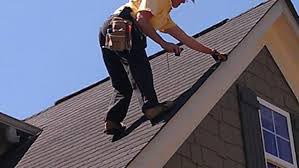From the desk of
Arthur S. Lazerow
Chairman, Alban Inspections, Inc
And Retired Home Inspector

June Newsletter 2019
Think about this: How would you like to stand outdoors every day of the summer with no sunscreen and also endure every thunderstorm with no umbrella? Sounds uncomfortable, but this is what is happening all summer to your clients’ roofs. As a retired home inspector, I would argue that much of a roof’s deterioration occurs during the summer. UV rays are absorbed by the asphalt or other roofing material and overhanging branches permit rain to drip, drip, incessantly onto roof materials below. Expansion of the roof surface during the heat of the day is followed by contraction as the night temperatures cool. All this spells deterioration.
But what to do?
Actually, not much, except homeowners should be conscious of the condition of their roofs. Something to have in mind is that roofs are a means of protecting the interior from getting wet. Roofs are water-resistant, not waterproof. Eventually, every roof will deteriorate and leak unless steps are taken to prevent this from happening. One very common cause of roof material deterioration is overhanging tree branches. Pruning of any overhanging branches is recommended to eliminate the constant drip, drip of rainwater after every storm, which accelerates deterioration.
Strong winds or heavy hail can cause damage to any asphalt shingle roof. After a storm, homeowners should take a look at their roofs. If anything looks amiss, hire a licensed roofer or certified home inspector to get an opinion of the condition of the roof.
Also, roof and surface water must be controlled to maintain a dry basement. This means keeping gutters cleaned out and aligned, extending downspouts, installing splash blocks, and building up the grades near the foundation so that roof and surface water are diverted away from the building.
Here is some quick roof information: In the temperate climates of the Mid-Atlantic States, asphalt and fiberglass shingle roofs have a normal life of 15 to 20 years. If a new roof is required, it may be installed over the original roof unless prohibited by local building codes. If two layers of roofing have already been installed, most building codes require both layers to be removed before installing a new roof covering. Roofs are built with different “pitches.” The roof pitch generally determines what material that can used. A roof pitch of 4 vertically to 12 horizontally at a minimum is needed if asphalt shingles are the materials on the roof. Also, wood shingles and shakes have more insulating value than other roofs.
Respectfully,
Art Lazerow

